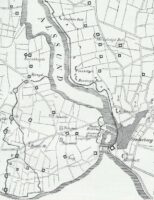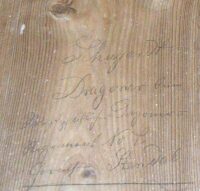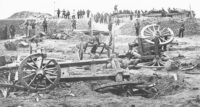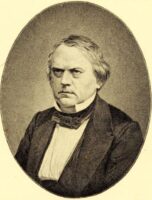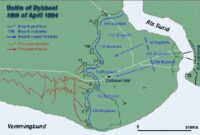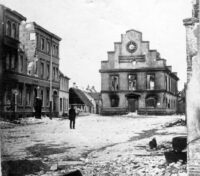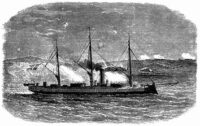In 1862-63, Danish engineer troops built the 10 redoubts of the Dybböl stronghold, a position in a half-arc from the waters of Vemmingbund to the Als Sund. Due to savings, the redoubts were built with wooden blockhouses as a shelter for the crew instead of concrete. Only the ammunition magazines were erected in concrete, which later cost the lives of many soldiers.
On February 7, 1864, the Danish army arrived at The Dybböl redoubts after they had been withdrawn from the Dannevirke in order to prevent the Prussian-Austrian army from encircling and destroying the army.
After an exhausting march and a bloody battle fought by the rear squad, 20,000 men, 500 riders, 80 field guns and 1,100 fortress artillerists reached the Dybbøl redoubts.
The commanding general De meza was removed and replaced with General Gerlach after the Dannevirke withdrawel.
The hostile forces that were just as exhausted as the Danes followed only slowly. However, the Prussian avant-garde arrived as early as February 8.
The Prussian forces slowly built up. Around February 20, the Prussians had 20,000 men, 1,200 riders and 88 guns in front of the post. The Prussians set up batteries, the most dangerous in the flank of the stronghold at the Broager on the other side of Vemmingbund.
From here, it was possible to bombarde the Danish redoubts on the left flank of the stronghold without the Danish artillery being able to respond effectively again.
The Danes were preparing to defend the redoubts and took a stand in the terrain in front of them.
On February 17, the Prussians began to close up, and in the following weeks a fierce battle took place in the outpost terrain, with the Danes slowly being forced back to the redoubts by a superior force.
On March 17, a Danish counter attack against Rageböl was fought back, and the army was forced back to the redoubts again.
In connection with these outpost battles, there were very tough battles around the Dybböl village and especially the church and the cemetery. Here, too, the Danes had to give way.
The Dybbøl Church tower was used as an observation post by both the Danes and the Federal Army. In connection with the observation service, several soldiers have written on the wall of the tower. This “graffiti” is still visible, but somewhat difficult to read.
Now the siege of Dybbøl began. The Prussians had collected 126 guns and mortars, and now the most severe bombardement in the history of war began. For weeks, thousands of grenades rained down on the Danish positions, without the Danish artillery being able to respond effectively.
The Danish soldiers could just hide in the trenches and foxholes and watch as long-range Prussian artillery shattered the positions. The damage to the redoubts and ramparts were repaired at night, only to be destroyed again the following day. Meanwhile, the enemy engineer troops dug their trenches closer and closer to the redoubts
Staying in the redoubts during this bambardement was a meaningless slaughter and would end up destroying the army, and all the leading Danish officers initially agreed that the position should be vacated. But the generals also knew how much importance the government put in maintaining a symbolic foothold on the mainland of Schleswig. Without this footing, future border talks would be almost symbolic.
The British government had called for a London peace conference to begin on 12 April. The Danish prime minister Bishop Monrad, was of the opinion that if the Danish army was still in Schleswig, it would be of great political importance during the negotiations. Therefore, he would not allow the army to escape the Dubböl stronghold. Conversely, the Prussian head of government Otto von Bismarck, had no plans to begin the peace talks until the Dybböl stronghold was conquered. The situation became increasingly untenable.
On April 9, the new General Gerlach telegraphed to the Ministry of War and raised the issue very clear: Will you keep the Dybbøl stronghold or have a army that is useful ?
The answer from Minister of War was clear enough: the position should be kept “to the extreme”.
Everyone in the officer corps knew that the Prussians would soon be attacking and that it would become the pure slaughterhouse. General Gerlach telegraphed again to Copenhagen, this time on behalf of the entire army leadership. Now Dybbøl should be abandoned – everything else would not be justifiable.
Lundbye wavered. He didn’t dare take responsibility, but Prime minister Monrad did. He maintained that it was crucial that the army defended the Dybbøl stronghold and fought back the attack that everyone knew would come.
Cannons and fortifications were destroyed and soldiers killed or wounded. The wooden block houses, which had been made to protect the soldiers, were easily pierced by the 12 and 15 cm grenades.
In one case, a grenade penetrated a little window, exploded inside, killing or injuring 42 men.
During the day, the soldiers sought cover in their foxholes and tried to get some rest, while in the evening they worked desperately to repair the damage caused by today’s bombing. The Danish force waned day by day, but the morale was still high considering the trials facing the Danish soldiers.
On March 28, the Prussians attempted an attack on the stronghold, but the attack was rejected using both army and navy.
The 2-3. April Sønderborg was set on fire by a bombardement and large parts of the center were damaged or destroyed. Many civilians lost their lives.
From April 7, the decisive artillery battle began, in which the position was being prepared for an attack.
This bombing lasted until April 18, at 4 am, where the number of grenades were doubled . The Prussians fired 7,900 grenades at the post four hours before the storm.
The redoubts were now reduced to gravel and piles, the obstacles almost completely destroyed but with a few functioning cannons left.
There was no way the remaining Danish guns could hit the German batteries from the redoubts, except the redoubt No. II, which was the only one able to reach the Prussian batteries at Broager. That is why especially this redoubt was particularly exposed to fire from the German batteries at Broager.
Only when the iron clad Rolf Krake showed up in Vemmingbund and fired at Broager, the German batteries were disturbed.

